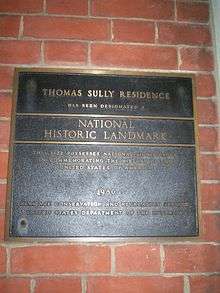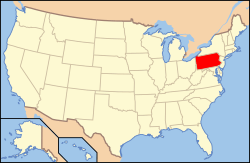Thomas Sully Residence
The Thomas Sully Residence is a historic rowhouse at 530 Spruce Street in Philadelphia, Pennsylvania, USA. It was briefly (1828-29) a home of painter Thomas Sully (1783-1872), who lived in Philadelphia for the last 64 years of his life. It was declared a National Historic Landmark in 1965.[2][3] It is a private residence, and is not open to the public.
Thomas Sully Residence | |
_cropped.jpg) Thomas Sully Residence | |
   | |
| Location | 530 Spruce St., Philadelphia, Pennsylvania |
|---|---|
| Coordinates | 39°56′42″N 75°9′5″W |
| Built | 1828 |
| NRHP reference No. | 66000691 |
| Significant dates | |
| Added to NRHP | October 15, 1966[1] |
| Designated NHL | December 21, 1965[2] |
Description and history
The Thomas Sully House is located in Philadelphia's Center City, on the south side of Spruce Street roughly midway between 5th and 6th Streets. It is one of several brick rowhouses on the block. It is 3-1/2 stories in height, with a gabled roof pierced by a single gabled dormer. The facade is three bays wide, with the entrance in the rightmost bay. The entrance is framed by pilasters, and a transom window with cornice above. The trim is all white marble. The building is not architecturally distinguished.[3]

The house was built in 1820, with subsequent construction in 1860.[4] It is one of many homes occupied by the painter Thomas Sully during 64 years of residence in the city. Although he was born in England, Sully came to the United States as a child in 1792, and became one of the nation's most prolific painters of the first half of the 19th century, producing more than 2,600 works in his long career. After living in Charleston, South Carolina and New York City, Sully came to Philadelphia in 1808. It remained his home until his death in 1872, although he is recorded as living at many different local addresses.[3]
See also
| Wikimedia Commons has media related to Thomas Sully House. |
References
- "National Register Information System". National Register of Historic Places. National Park Service. January 23, 2007.
- "Thomas Sully Residence". National Historic Landmark summary listing. National Park Service. Retrieved 2008-02-17.
- Richard E. Greenwood (October 9, 1974). "National Register of Historic Places Inventory-Nomination: Thomas Sully Residence" (pdf). National Park Service. Cite journal requires
|journal=(help) and Accompanying one photo, exterior, from 1974 (32 KB) - Gombach, Julia. "Philadelphia National Historic Landmarks". livingplaces.com. Retrieved June 2010. Check date values in:
|accessdate=(help)

